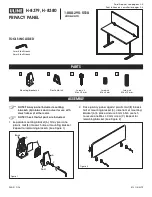
9
4.1.1 Pump
The pumps of the pump unit are non-self-priming, single-stage
Grundfos NKF standard pumps with spiral housing. The pumps
have an axial suction port and a radial discharge port with PN 10
or PN 16 flanges according to EN 1092-2.
The NKF pumps are available in these models:
Model A
NKF 200-500.
Model B
NKF 50-200, NKF 65-200, NKF 80-200, NKF 80-250,
NKF 150-400, NKF 150-500.
The impeller diameter can be reduced to customise the pump
performance to a certain duty point. The actual impeller diameter
may therefore deviate from the standard diameters stated in
catalogues, data sheets etc. The actual impeller diameter is
stated on the pump nameplate.
The NKF pump is equipped with a rubber bellows seal, type
BAQE, with sealing faces of metal-impregnated carbon/silicon
carbide. The elastomer parts are of EPDM.
4.1.2 Engine
The pumps are driven by a stationary 4-stroke diesel engine from
John Deere which has been especially adapted to meet the
requirements of fire pumps.
The nominal engine power is adapted to the power requirement
of the pump. The adaptation is via the engine speed, which may
therefore not be changed. The table shows the relationship
between the diesel engines to the individual pumps. Depending
on output, the engines have a turbocharger and, if necessary,
also a charge air cooler.
The engine is cooled via a heat exchanger. The cooling liquid is
led to the heat exchanger via a pipe connected to the discharge
port of the pump. The discharge from the heat exchanger is led
via an open outlet according to VdS regulations.
4.1.3 Controller
The pump unit is controlled via a Minimax controller especially
sized for diesel engines driving fire pumps. The purpose of the
PLC controller is to start the pump automatically and monitor the
diesel engine.
As soon as the sprinklers are activated due to an alarm and water
is consumed, the pressure in the discharge pipe is reduced. If the
pressure becomes lower than the
start pressure
set at the
pressure switch, the pump starts automatically.
The pump is stopped manually via the controller.
General construction
The controller is in a control cabinet mounted on the base frame.
The controller is operated by means of the control panel in the
cabinet door. See fig. 9. The control cabinet supplies the engine
with the power required for starting and operating the engine. If
the power supply fails, the two redundant starter sets take over
this task.
Fig. 9
Control panel
Note
NKF pumps are approved by VdS for use in fire
systems.
Pump type
Engine type
Fire NKF 50-200
JU4H-NL14
Fire NKF 65-200
JU4H-NL14
Fire NKF 80-200
JU4H-NL14
JU4H-NL24
Fire NKF 80-250
JU4H-NL24
JU4H-NL34
Fire NKF 150-400
JU4H-NL50
JU6H-NL30
JU6H-NL50
JU6H-NL60
JW6H-NL30
Fire NKF 150-500
JU6H-NL60
JW6H-NL30
JW6H-NL40
Caution
The injection pump has been set from factory,
and the setting must not be changed.
Note
The engines meet the requirements of VdS.
Note
The controller has a VdS approval for use in fire
systems.
TM
03
99
37
46
07
Indicator lights on control panel
Alar
m/
fa
u
lt
Status
Indicator
light
Description
H1
Green
Fire pump operation
H2
White
Fire pump stopped
H3
Yellow
Common fault
H4
Green
Processor on
H5
Green
Blinds, air in, open
H6
Green
Blinds, air out, open
H7
Green
Pressure switch 1 triggered
H8
Yellow
Pressure switch 1 fault
H9
Green
Pressure switch 2 triggered
H10
Yellow
Pressure switch 2 fault
H11
Green
Starting/ready
H12
Red
Error start
H13
Red
Diesel auto-start locked
H14
Yellow
Battery set 1 fault
H15
Yellow
Battery set 2 fault
H16
Green
Motor monitoring on
H17
Red
Oil pressure low
H18
Red
Overtemperature
H19
Red
Fuse blown
H20
Yellow
Electric generator dropped out
H21
Red
Fuel tap closed
H22
Yellow
Transmission path fault
H23
Red
Fuel shortage
H24
Yellow
Transmission path fault
H1
H2
H3
H7
H8
H11
H12
H13
H14
H15
H21
H22
BS1
H4
H5
H6
H9
H10
H16
S1
S2
S3
S4
S6
S5
P1
P2
H0
Dis.
S7
H17
H18
H19
H20
H23
H24
BS2
P8
xxxxx
P4
P5
P6
P7
P3
XXXXXXX
V
A
V
A










































